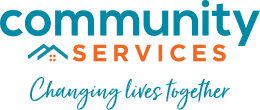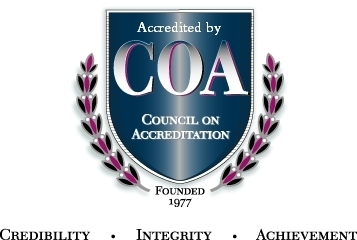Accreditation
The Council On Accreditations (COA) accreditation process is client-centred and supportive of the unique cultural needs and goals of Community Services and the people we serve. To meet accreditation, organizations must be accredited every four years. Community Services has been accredited with the Council On Accreditation (COA) since 2003 and approved until 10/31/2027.
For more information please click on the link to be redirected to the COA website
Performance Quality Improvement
Community Services promotes quality programs and services through an extensive and interconnected quality improvement system of data collection, feedback, analysis, implementation, action and evaluation.
Community Services Performance Quality Improvement (PQI) Plan and PQI Framework
Community Services is an organization that promotes an environment of best practice and on-going improvement throughout all levels of the organization including program locations, staff, volunteers and stakeholders including satisfaction surveys and outcome measures. Data collection occurs throughout all levels of the agency using focus groups, satisfaction surveys, outcome measurement tools, complaints and feedback mechanisms. Evaluation of the various forms of data is reviewed by program coordinators and supervisors against bench marks and success indicators. The primary purpose of data collection and analysis is to look for ways to improve the programs and services… Service evaluation and service improvements are evident on a continuous basis throughout the organization.
The PQI Framework is a diagram that captures the performance and quality improvement mechanisms throughout the agency and the important components of the agency’s improvement cycle:
- Flow of information is transparent and 2-ways
- Information is collected from a variety of internal and external sources
- Service improvements are made based on data collection, evaluation and action
- Overall evaluation is based on expectations and targets from program reports, strategic planning and service goals
Board Governance
Community Services, is governed by a volunteer Board of Directors. Board members are voted in as Board members through a nomination process with the Board as a whole serving as the nominating committee who vote on successful applicants. Board members are generally sought out from the community as individuals who bring a specific leadership and skill set to the Board such as experience working with government contracts or accounting experience for example. The Board of Directors is ultimately responsible for the direction of the agency and accomplishes this through approving agency policies and direction to the Executive Director for the day-to-day management of the agency. The overall leadership decisions of the Board of Directors is built on their knowledge and involvement of the agency through the PQI process such as reports, events, presentations and information. The Board’s direction is also set through their involvement and approval of the agency’s strategic business plan.
The Board of Directors receives the following reports and information:
- Monthly Board meetings that include program updates, relevant issues or potential risks
- E.D. reports including program highlights, legal issues, funding issues and complaints/grievances
- Monthly financial statements
- Internal committee reports such as PQI minutes & Risk and Remedy
- Annual General Meeting (AGM)
- Strategic Business Plan (participation and approval)
Events and Presentations include:
- Staff Appreciation
- Mental Health Awareness Day
- Strategic Focus Group meetings
- Program events such as Aboriginal Day or Seniors Awareness Tea
Management Team & Executive Director
The Executive Director is ultimately responsible for the day to day operations of the agency as directed by the Board of Directors and an active member of the management team. The Management Team is responsible for the overall implementation of agency policies and procedures, adherence to the collective agreement, implementation of accreditation standards and active collaboration and promotion within the agency and community as a whole. For overall decision and leadership for the agency; The Management Team builds the agency strategic plan, sets performance targets, evaluates program service delivery and disseminates information as needed throughout the agency and community. With direction to the Executive Director, the Management Team is responsible for the implementation of the overall PQI plan.
Performance Quality Improvement Committee (PQI Committee)
The PQI Committee is a standing component of the Agency’s Accreditation Readiness Team Committee (ART committee). The ART committee consists of representation from internal committee chairs such as Occupational Health and Safety and Training and Development, Managers, Program Supervisors and Program Coordinators. The PQI component of the ART meetings provides a consistent opportunity at the monthly meetings to focus on overall quality improvements systems throughout the agency. Information is viewed from all internal committees, external committees, annual reports including programs and services and human resources as well as program successes. The PQI component of the ART meeting also provides an efficient mechanism for feedback on information and reports by having key representation at the meetings, including managers, which makes improvement decisions transparent, responsive and collectively shared amongst all levels of the agency.
Information collection, evaluation and action include:
- Annual program reports including trends and service improvements
- Staff orientation summary and recommendations for improvements
- Stakeholders survey information and recommendations
- Internal committee reports/minutes including OH&S, T&D, CQI file review, fund development
- External committee reports including CN community network
Programs and Services
Program supervisors and program coordinators are responsible for the operations of programs and services. Each program operates within the agency’s Mission and established policies and procedures designed to fulfill services deliverables as established by the funding contract or service description. Annual data is collected for each program that highlights service trends, patterns, and collected satisfaction and outcome information with the program’s response for improvement. Annual reports also capture the program’s involvement in the community, impact to clients as well as overall evaluation of established service targets. Annual program reports are shared with funding bodies as well as the agency’s PQI committee. The annual program report criteria include the following:
- Overall program purpose
- Overall achievements of the program
- Program capacity as well as comparison to previous service capacity
- External reviews specific to the program such as licensing
- Service trends and patterns
- Programs involvement in the community
- Performance quality improvements made throughout the course of the year
- Satisfaction survey data from the year and improvement strategies including designated responsibility
- Outcome survey data from the year and improvement strategies including designated responsibility
Internal Agency Committees
Community Services accomplishes a significant amount of quality improvement work through the successful structure of internal committees that include:
- Occupational Health and Safety (OH&S)
- Training and Development (T&D)
- Marketing & Communications
- Continuous Quality Improvement (CQI file review committee)
- Risk and Remedy (R&R)
- Performance Quality Improvement (PQI/ART)
The agency’s internal committee structure provides an organized and resourced mechanism for specific operations of the overall PQI plan including: collection of information, analysis and response to that information that ultimately builds service changes and improvements. Internal committees are comprised of representatives from all levels of the organization and from all locations including the main office and satellites facilities, to evaluate the agency’s work and progress towards internal administrative and service targets.
External Community Committees
Community Services recognizes and values the collaborative work in the communities of Maple Ridge and Pitt Meadows. Community committees provide tremendous opportunity for agency staff and management to participate in overall community initiatives that relate to agency programs. Involvement in community also provides greater resources for information collection, information sharing, fund development and cost sharing. It is highly recognized by the Agency that community involvement and leadership fulfills the agency’s mission that is positive and efficient practice that builds personal and agency capacity. External committees include:
- Community Network (CN)
- Early Childhood Development Committee (ECD)
- Middle Childhood Matters Committee (MCM)
- Seniors Planning Table
- Aboriginal Board of Directors / Joint Working Group
- Mental Health Consumer Advisory Committee
- Anti-Violence Committee
- Transition Committee – Community Living
Internal Stakeholder Involvement
Internal Stakeholders include personnel who provide direct service: volunteers, staff, coordinators, supervisors and managers. Information is collected from internal stakeholders and used to drive the quality improvement systems throughout the agency. Once the various information is collected; the aggregate data is rolled up into a report format.
The overall report and improvement recommendations are discussed at the agency’s PQI meeting with final decisions and implementation taking place at the Management level of the agency. Information collected from internal stakeholder feedback is also shared with the Board of Directors on an on-going basis and shared at the agency’s annual general meeting. Internal stakeholder feedback mechanisms include:
- Exit Interviews
- Personnel surveys
- R&R reporting
- Training surveys
- On-going suggestions / feedback
Client Feedback
Feedback from clients and their family members is critical to the on-going evaluation of service provided by the agency. It is highly recognized throughout the agency that one of the most valuable mechanisms of service evaluation is to ask the service recipients and then do something with the information to improve the program. Examples of client feedback mechanisms include:
- Client satisfaction surveys – collected during service or at least annually. Community Services builds individual and community capacity through extensive and interconnected aspects of a quality improvement system of data collection, feedback, analysis, implementation and action.
- Client outcome surveys – collected at the completion of service or at least annually. Community Services builds individual and community capacity through extensive and interconnected aspects of a quality improvement system of data collection, feedback, analysis, implementation and action.
- Client complaints – collected on an as needed basis. Complaints are responded to by the Executive Director or delegate. Aggregate complaint information is shared with the agency’s PQI committee and Board of Directors.
Community Awareness
Community Services promotes the various programs and services throughout the entire community using a variety of promotional mediums such as local newspapers, email distribution lists and agency website. Feedback from the community is also requested by the agency using a number of mechanisms including suggestion boxes located at all locations, agency website and surveys. Promotion and information takes place by:
- Annual General Meetings AGM
- Website
- Social Media
- Promotional material such as brochures, flyers, posters
- Presentations such as service clubs, government
- Events such as Mental Health Awareness Day, Aboriginal Day, Seniors Week
Dissemination of information is but a part of the important improvement cycle. Once information is collected from the various aspects of PQI within the agency; the critical component is doing something constructive with the information. A significant advantage for Community Services is that being an organization of this size; many program coordinators, supervisors and managers participate on many different internal and external committees. The distinct advantage that this brings is the sharing of information and strategizing that occurs throughout the agency and throughout the community to improve services overall. Conversations and plans include sharing of resources, joint funding applications, advocating for policy change, service duplications and reducing barriers for staff and clients. Examples include:
- Staff meeting discussion of parent barrier to service – community ECD discussion and strategizing – policy change / service target = reduced barrier for parents with increased parent participation and increased client satisfaction and increased client outcome.

